In This Issue....
From the EditorIn the News
Ladies' Ellesmere Vacation
Sled Dog Physiology: Non-Invasive Techniques
BAS Vignette: How Do You Say Good-bye?
Sledge Dog Memorial Fund Update
Report: The Chinook Project in Kimmirut
Bannock revisited
Book Review: Land of the Long Day
Behavior Notebook: On Being a Social Facilitator
Tip: Dealing with Those "Dirty" Boots
Index: Volume 10, The Fan Hitch
Navigating This
Site
Index of articles by subject
Index
of back issues by volume number
Search The
Fan Hitch
Articles
to download and print
Ordering
Ken MacRury's Thesis
Our
comprehensive list of resources
Talk
to The
Fan Hitch
The Fan
Hitch home page
ISDI
home page
Editor's/Publisher's Statement
Editor: Sue Hamilton
Webmaster: Mark Hamilton
The
Fan Hitch, Journal of the Inuit Sled
Dog, is published four times a year. It is
available at no cost online at:
https://thefanhitch.org.
The Fan Hitch welcomes your letters, stories, comments and suggestions. The editorial staff reserves the right to edit submissions used for publication.
Contents of The Fan Hitch are protected by international copyright laws. No photo, drawing or text may be reproduced in any form without written consent. Webmasters please note: written consent is necessary before linking this site to yours! Please forward requests to Sue Hamilton, 55 Town Line Rd., Harwinton, Connecticut 06791, USA or mail@thefanhitch.org.
This site is dedicated to the Inuit Dog as well as related Inuit culture and traditions. It is also home to The Fan Hitch, Journal of the Inuit Sled Dog.
The Fan Hitch welcomes your letters, stories, comments and suggestions. The editorial staff reserves the right to edit submissions used for publication.
Contents of The Fan Hitch are protected by international copyright laws. No photo, drawing or text may be reproduced in any form without written consent. Webmasters please note: written consent is necessary before linking this site to yours! Please forward requests to Sue Hamilton, 55 Town Line Rd., Harwinton, Connecticut 06791, USA or mail@thefanhitch.org.
This site is dedicated to the Inuit Dog as well as related Inuit culture and traditions. It is also home to The Fan Hitch, Journal of the Inuit Sled Dog.
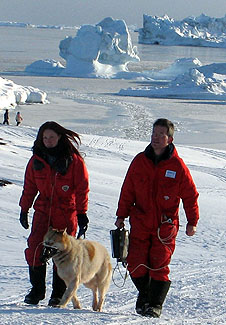
This dog is fitted with a portable respirometer
that can monitor several different functions
simultaneously. photo: A. Purgue
Alternatives in physiological research
using non-invasive methods in field biology
by Nadine Gerth
I am a biologist conducting my Ph.D. studies in the Functional Morphology group led by Prof. J.M. Starck at the University of Munich (LMU), Germany. We work with Inuit Sled Dogs, studying their responses to the extreme seasonal fluctuations in their natural environment and in their living conditions; particularly changes in temperature, exercise, and food supply. Winter temperatures in Greenland range around -30°C (-22°F), whereas the Greenlandic summers are rather mild with temperatures around 10°C (50°F). For the sled dogs winter is the active time of the year when they are used for transportation and hunting on a regular basis. When the sea ice breaks up, the dogs are chained to rocks outside the villages and remain there until the sea ice is thick enough to start the next hunting season. During the working season the dogs are fed regularly with high quality meat (whale, walrus and seal meat), but during the inactive summer time the dogs are fed just once or twice a week and they receive relatively low quality food, i.e. fish. Sometimes they have to endure prolonged periods of fasting.
We are interested to see how the dogs adjust to increased workload, cold temperatures and regular food supply during winter compared to the lazy, mild summer conditions when they receive food only intermittently. Possible adjustments would be an up-regulation of the energy metabolism, an increase in muscle size, heart size and the size of the intestines during winter. In summer 2005 and winter 2006 we studied two dog teams on Disko Island in Western Greenland and in summer 2007 and winter 2008 we worked further north in Qaanaaq, Thule district, to investigate another two dog teams of active Inuit hunters. The sled dogs we have studied have all been kept exclusively as working dogs under local husbandry conditions by their Greenlandic owners.
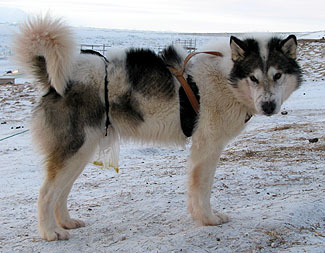
What will his teammates think about this? photo: N. Gerth
Open flow respirometry is a standard technique in human exercise physiology to measure oxygen consumption and carbon dioxide production as well as breath volume and respiration rate while exercising or resting. Originally these respirometry systems were large, stationary units requiring a laboratory setup where the subject either sits in a respirometry chamber or wears a mask connected to the measuring equipment. With the development of small portable units it became possible to conduct measurements, for example, while the subject is running in the field or hiking in the mountains. Such a device consists of a breathing mask with a turbine connected to it and a small recording unit that is placed onto the chest of the subject. Sub-samples of exhaled air are collected and an integrated gas analyzer records the oxygen and carbon dioxide content of the samples. We have adjusted this system to fit onto a dog’s face and modified the software to measure dog physiology rather than human physiology. A challenge was to build an airtight breathing mask that is robust enough to protect the sensitive electronic parts and cables when walking the dogs in the field. The recording unit was carried by the dog handler in the field. To our surprise it was no problem at all to get the dogs to wear the mask while walking on a leash. When we settled down next to the resting dogs to measure resting metabolic rate, they often times quickly fell asleep while wearing the mask. Working tolerance of this piece of equipment and its measurements were affected by strong wind and temperatures below -20°C (-4°F).
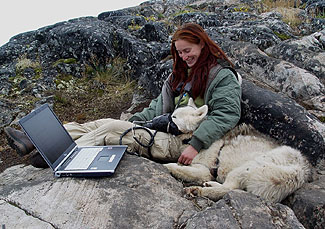
Scientist and dog working and relaxing at the same time!
photo: J.M.Starck
The dogs' heart rate while resting and working was another parameter of interest. The traditional way to record heart rates of an animal over longer periods would be to implant recording units into the animal, a procedure that bears the risk of inflammation and other complications attributed to anesthesia and a long recovery period. Instead, we used commercially available heart rate belts and monitor watches, as used by human athletes, to record the heart rate of dogs while resting, walking, and running. To ensure signal transmission from the dogs' heart through the thick fur to the electrodes inside the chest belt we used an aqueous gel. Thus we could avoid shaving the dogs. In winter, we added a layer of neoprene on top of the belts to prevent the gel from freezing and the dogs from getting cold. The receiver watch was attached to the dogs' collars.
One of the aims of this project is to study organ size changes in response to fluctuating environmental conditions. Traditionally, one would kill and dissect the experimental animals and compare the measurements of organs of animals kept under different conditions. For statistical reasons, such an approach involves killing of a large number of animals. This was no option in our project since we worked with dog teams of active Inuit hunters and because we wanted to compare the same dogs during summer and winter. We used transcutaneous ultrasonography to measure the size of various organs and we could repeatedly measure the same individual animal under both working and resting conditions; thus each individual serves as its own control. Therefore, far fewer animals had to be measured than the more traditional approach would require, and none died. We used the portable ultrasonography unit, even at -25°C (-13°F), on the sea ice to measure parameters of heart morphology, intestines, muscle size, and even the blood flow in the veins and arteries in the legs of a standing dog. The standard setup for these measurements in an animal hospital would be that the animal lies on its side during the procedure. Our dogs were standing to avoid stress when being forced to lie down in front of their teammates, or - even more taxing - being taken away from the team for the measurements.
Challenging for field work in remote places is transporting the supply of coupling gel that is crucial for signal transmission. For our measurements about 100 liters (about 26 gallons U.S.) of gel would have been necessary to be shipped to the study area. We solved the problem by preparing our own coupling gel using powder, available from a pharmacy, designed for blending homemade hair gel. This gel does not clump the fur, is neither harmful when ingested nor does it irritate the animal's skin.
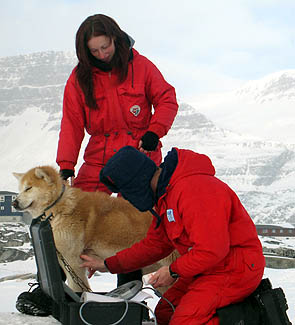
Gel placed on the chest behind the elbow will enable
the portable ultrasonograph to measure the size and
morphology of this dog’s heart. photo: A. Purgue
As scientist working with living creatures, I think it is important to remain open-minded when planning experiments and to not always stick with the standard techniques of the particular research field, but to search for new tools from other fields and implement them into the research. This can be beneficial - even life saving - for the experimental animals, and challenging, but also great fun for the researcher. The dogs involved in this study were happy to see us again when we arrived in the second (winter) season to do the same measurements as in the previous (summer) season. Clearly they enjoyed the additional attention they received during our work. For us working with the dogs under natural conditions instead of a laboratory setup was not just research but a lifetime experience.
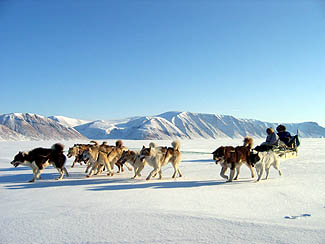
The legendary strength and stamina of the Inuit Sled Dog is
now the subject of scientific investigation. photo: N. Gerth